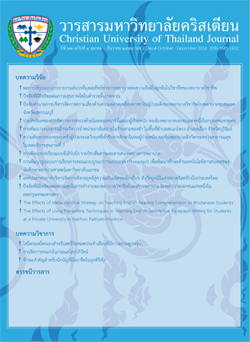ไฟโตรเอสโตรเจนสำหรับสตรีวัยหมดประจำเดือนที่มีภาวะกระดูกพรุน
บทคัดย่อ
กระดูกพรุนในสตรีวัยหมดประจำเดือนอันเกิดจากการที่ร่างกายขาดฮอร์โมนเอสโตรเจน ทำให้มีความแข็งแรงของกระดูกลดลง จนเกิดกระดูกเปราะบางและหักง่าย หากผู้ป่วยที่มีกระดูกหักจะต้องรับการผ่าตัด พักรักษาตัวในโรงพยาบาล และไม่สามารถช่วยเหลือตนเองได้ ซึ่งเป็นปัญหาสุขภาพสำคัญที่ทำให้ผู้ป่วยมีคุณภาพชีวิตต่ำลงองค์การอาหารและยาสหรัฐอเมริกาได้รับรองให้ใช้ฮอร์โมนเอสโตรเจนทดแทนในการรักษากลุ่มอาการอันไม่พึงประสงค์และป้องกันโรคกระดูกพรุนในสตรีวัยหมดประจำเดือนเพื่อลดการสลายและเพิ่มการสร้างมวลกระดูก แต่การใช้ฮอร์โมนทดแทนมีข้อห้ามใช้และการใช้เป็นเวลานานอาจพบผลข้างเคียง ได้แก่ กล้ามเนื้อหัวใจตาย โรคหลอดเลือดสมอง มะเร็งเต้านม มะเร็งมดลูก ดังนั้น พืชหรือสมุนไพรไทยที่มีสารไฟโตรเอสโตรเจนอาจเป็นอีกทางเลือกหนึ่งนอกเหนือจากฮอร์โมนทดแทนในสตรีวัยหมดประจำเดือนที่มีภาวะกระดูกพรุนแต่อย่างไรก็ตามต้องมีการศึกษาถึงขนาดระยะเวลาการใช้ที่เหมาะสม และความปลอดภัยในระยะยาวเพิ่มเติมเพื่อนำข้อมูลที่ได้ไปประยุกต์ใช้ทางคลินิกได้อย่างมีประสิทธิภาพต่อไป
เอกสารอ้างอิง
กองควบคุมอาหาร สำนักงานคณะกรรมการอาหารและยา. (ม.ป.ป.). ข้อมูลด้านวิชาการของกวาวเครือ.[ออนไลน์]. สืบค้นเมื่อวันที่ 1 พฤษภาคม 2559, จาก https://www.oryor.com/oryor/admin/module/fda_fact_sheet/file/f_116_1258449347.pdf
จีรนันท์ แกล้วกล้า และ จารุวรรณ ไผ่ตระกูล. (2551). "ความสัมพันธ์ของการบริโภคแคลเซียมจากอาหารและการออกกำลังกายกับโรคกระดูกพรุนในหญิงวัยหมดประจำเดือน กรุงเทพมหานคร". วารสารมหาวิทยาลัยคริสเตียน. 14(3): 196-202.
นงพิมล นิมิตอานันท์. (2552). "สุขภาพสตรีวัยหมดประจำเดือน". วารสารมหาวิทยาลัยคริสเตียน. 15(3): 189-198.
บัญชียาหลักแห่งชาติ. (2556). ประกาศคณะกรรมการพัฒนาระบบยาแห่งชาติ เรื่อง บัญชียาหลักแห่งชาติ.[ออนไลน์]. สืบค้นเมื่อวันที่ 1 กุมภาพันธ์ 2559, จาก https://www.thaihof.org/sites/default/files/herbal_book_56_0.pdf.
มยุรี จิรภิญโญ และ ชาญชัย สุชาติวัฒนชัย. (2550). ตำรานรีเวชวิทยา. พิมพ์ครั้งที่ 3. กรุงเทพฯ : บียอนด์ เอ็นเทอร์ไพรซ์.
วิภาวี ลักษณากร. (2552). ชุดความรู้เบื้องต้นเรื่องการป้องกันโรคกระดูกพรุนสำหรับประชาชน. พิมพ์ครั้ง ที่ 1. กรุงเทพฯ : มูลนิธิโรคกระดูกพรุนแห่งประเทศไทยฯ และมหาวิทยาลัยมหิดล.
สำนักงานคณะกรรมการพัฒนาการเศรษฐกิจและสังคมแห่งชาติ. (2556). การคาดประมาณ ประชากรของประเทศไทย พ.ศ. 2553-2583. พิมพ์ครั้งที่ 1. กรุงเทพฯ : โรงพิมพ์เดือนตุลา.
Chang, K., and et al. (2013). "Combined effect of soy isoflavones and vitamin D3 on bone loss in ovariectomized rates". Nutrition. (29): 137-48.
Chawla, A., and et al. (2011). "Asparagus racemosus (Willd) : Biological activities and its active principles". Indo-Global Journal of Pharmaceutical Sciences. 1(2) : 113-120.
Chitme, H., and et al. (2009). "Effect of Asparagus RacemosusWilld root extract on ovariectomize rats". The Open Natural Products Journal. (2) : 16-23.
Choombuathong, A. (2015). "Puerariamirific: Queen of Thai herb". Journal MSU.34(2) : 202-209.
Hendrich, S., and Murphy, P. A. (2001). Handbook of nutraceuticals and functional foods. Clifornia : CRC Press.
Jongkon, N., and Tangyuenyongwattana, P. (2014). "Molacular binding modes of diarylheptanoids from curcuma comosa on the ER-receptor". TJPS. 38(2): 82-89.
Khan, A., and Fortier, M. (2014). "Osteoporosis in Menopause". J ObstetGynaecol Can. 36(9): S1-S15.
Kohli, S.S and Kohli K. V. (2011). "Role of RANKL-RANK/osteoprotegerin molecular complex in bone remodeling and its immunopathologic implications". Indian Journal of Endocrinology and Metabolism. 15(3): 175-81.
Ma, D., and et al. (2008). "Soy isoflavone intake increases bone mineral density in the spine of menopausal women: Meta-analysis of randomized controlled trials". Clinical Nutrition. (27): 57-64.
Manonai, J., and et al. (2008). "Effects and safety of Puerariamirifica on lipid profiles and biochemical makers of bone turnover rates in healthy postmenopausal women". Menopause. 3(15): 530-5.
Medicinal Plant Research Institute. (2000). Composition of Puerariamirifica. [Online]. Retrived March 1, 2015, from https://www.stherb.com/composition-of-pueraria-mirifica/.
Moreira, A., and et al. (2014). "Phytoestrogens as alternative hormone replacement therapy in menopause: What is real, what is unknown". Journal of steroid biochemistry and molecular biology. (143): 61-71.
National osteoporosis foundation. (2014). Clinician guide to prevention and treatment of osteoporosis. Washington DC: National osteoporosis foundation.
Singh, S.K., and Kulkarni, K.S. (2002). "Evaluation of the efficacy and safety on Menosan in post-menopausal symptoms: a short-term pilot study". Obs & Gynae. Today. 8(12): 727-730.
Stump, S.E. (2015). Nutrition diagnosis-related care eighth edition. China:Wolters Kluwer.
Tai, T., andet al.(2012). "The effect of soy isoflavone in bone mineral density in postmenopausal Taiwanese women with bone loss: a 2-year randomized double-blind placebo-controlled study". Osteoporos Int. (23): 1572-80.
Taku, K., and et al. (2010). "Effect of soy isoflavone extract supplements on bone mineral density in menopausal women: meta-analysis of randomized controlled trials". Asia Pac J ClinNutr. 19(1): 33-42.
Tantikanlayaporn, D., and et al. (2013). "A diaryheptanoid phytoestrogen from Curcuma comosa, 1,7-diphenyl-4,6-haptadine-3-ol, accelerates human osteoblast proliferation and differentiation". Phytomedicine. (20): 676-82.



